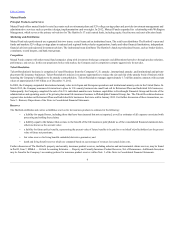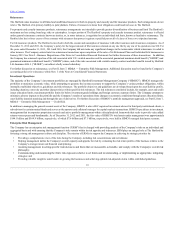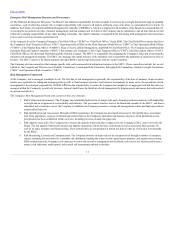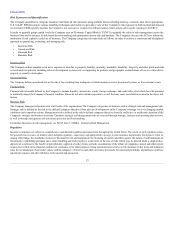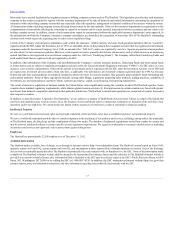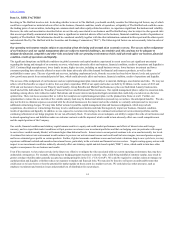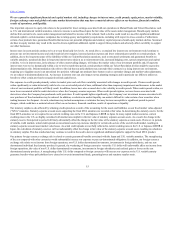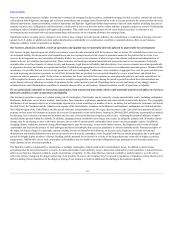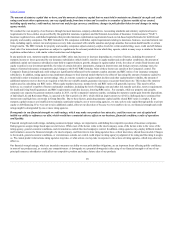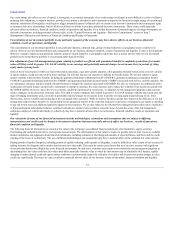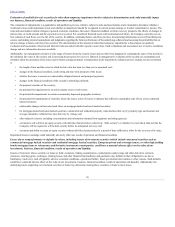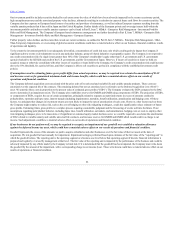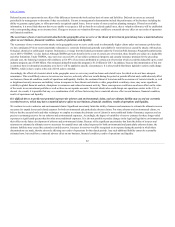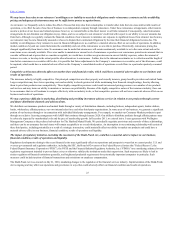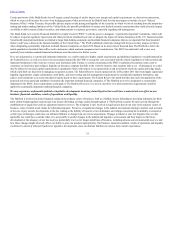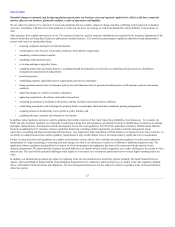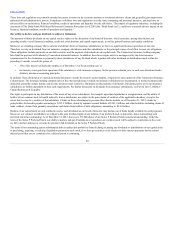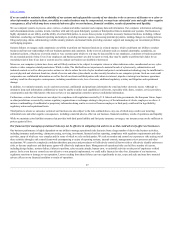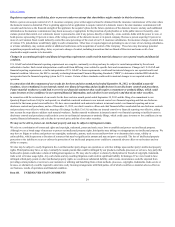The Hartford 2012 Annual Report Download - page 19
Download and view the complete annual report
Please find page 19 of the 2012 The Hartford annual report below. You can navigate through the pages in the report by either clicking on the pages listed below, or by using the keyword search tool below to find specific information within the annual report.
Table of Contents
Our credit ratings also affect our cost of capital. A downgrade or a potential downgrade of our credit ratings could make it more difficult or costly to refinance
maturing debt obligations, to support business growth at our insurance subsidiaries and to maintain or improve the financial strength ratings of our principal
insurance subsidiaries. Downgrades could begin to trigger potentially material collateral calls on certain of our derivative instruments and counterparty rights
to terminate derivative relationships, both of which could limit our ability to purchase additional derivative instruments. These events could materially
adversely affect our business, financial condition, results of operations and liquidity. For a further discussion of potential impacts of ratings downgrades on
derivative instruments, including potential collateral calls, see the "Capital Resources and Liquidity - Derivative Commitments" section of Item 7.
Management's Discussion and Analysis of Financial Condition and Results of Operations.
Concentration of our investment portfolio in any particular segment of the economy may have adverse effects on our business, financial
condition, results of operations and liquidity.
The concentration of our investment portfolios in any particular industry, collateral type, group of related industries or geographic sector could have an
adverse effect on our investment portfolios and consequently on our business, financial condition, results of operations and liquidity. Events or developments
that have a negative impact on any particular industry, group of related industries or geographic region may have a greater adverse effect on our investment
portfolio to the extent that the portfolio is concentrated rather than diversified.
Our adjustment of our risk management program relating to products we offered with guaranteed benefits to emphasize protection of economic
value will likely result in greater U.S. GAAP volatility in our earnings and potentially material charges to net income (loss) in periods of rising
equity market pricing levels.
Some of the in-force business within our Talcott Resolution operations, especially variable annuities, offer guaranteed benefits which, in the event of a decline
in equity markets, would not only result in lower earnings, but will also increase our exposure to liability for benefit claims. We are also subject to equity
market volatility related to these benefits, including the guaranteed minimum withdrawal benefit (“GMWB”), guaranteed minimum accumulation benefit
(“GMAB”), guaranteed minimum death benefit (“GMDB”) and guaranteed minimum income benefit (“GMIB”) associated with in-force variable annuities. We
use reinsurance structures and have modified benefit features to mitigate the exposure associated with GMDB. We also use reinsurance in combination with a
modification of benefit features and derivative instruments to attempt to minimize the claim exposure and to reduce the volatility of net income associated with
the GMWB liability. However, due to the severe economic conditions experienced in recent years, we adjusted our risk management program to place greater
relative emphasis on the protection economic value. This shift in relative emphasis has resulted in greater U.S. GAAP earnings volatility and, based upon the
types of hedging instruments used, can result in potentially material charges to net income (loss) in periods of rising equity market pricing levels, lower
interest rates, rises in volatility and weakening of the yen against other currencies. While we believe that these actions have improved the efficiency of our risk
management related to these benefits, we remain liable for the guaranteed benefits in the event that reinsurers or derivative counterparties are unable or unwilling
to pay and in turn may need additional capital to support in-force business. We are also subject to the risk that these management procedures prove ineffective
or that unanticipated policyholder behavior, combined with adverse market events, produces economic losses beyond the scope of the risk management
techniques employed, which individually or collectively may have a material adverse effect on our business, financial condition, results of operations and
liquidity.
Our valuations of many of our financial instruments include methodologies, estimations and assumptions that are subject to differing
interpretations and could result in changes to investment valuations that may materially adversely affect our business, results of operations,
financial condition and liquidity.
The following financial instruments are carried at fair value in the Company's consolidated financial statements: fixed maturities, equity securities,
freestanding and embedded derivatives, and separate account assets. The determination of fair values is made at a specific point in time, based on available
market information and judgments about financial instruments, including estimates of the timing and amounts of expected future cash flows and the credit
standing of the issuer or counterparty. The use of different methodologies and assumptions may have a material effect on the estimated fair value amounts.
During periods of market disruption, including periods of rapidly widening credit spreads or illiquidity, it may be difficult to value certain of our securities if
trading becomes less frequent and/or market data becomes less observable. There may be certain asset classes that were in active markets with significant
observable data that become illiquid due to the financial environment. In such cases, securities may require more subjectivity and management judgment in
determining their fair values and those fair values may differ materially from the value at which the investments may be ultimately sold. Further, rapidly
changing or unprecedented credit and equity market conditions could materially impact the valuation of securities and the period-to-period changes in value
could vary significantly. Decreases in value could have a material adverse effect on our business, results of operations, financial condition and liquidity.
19


